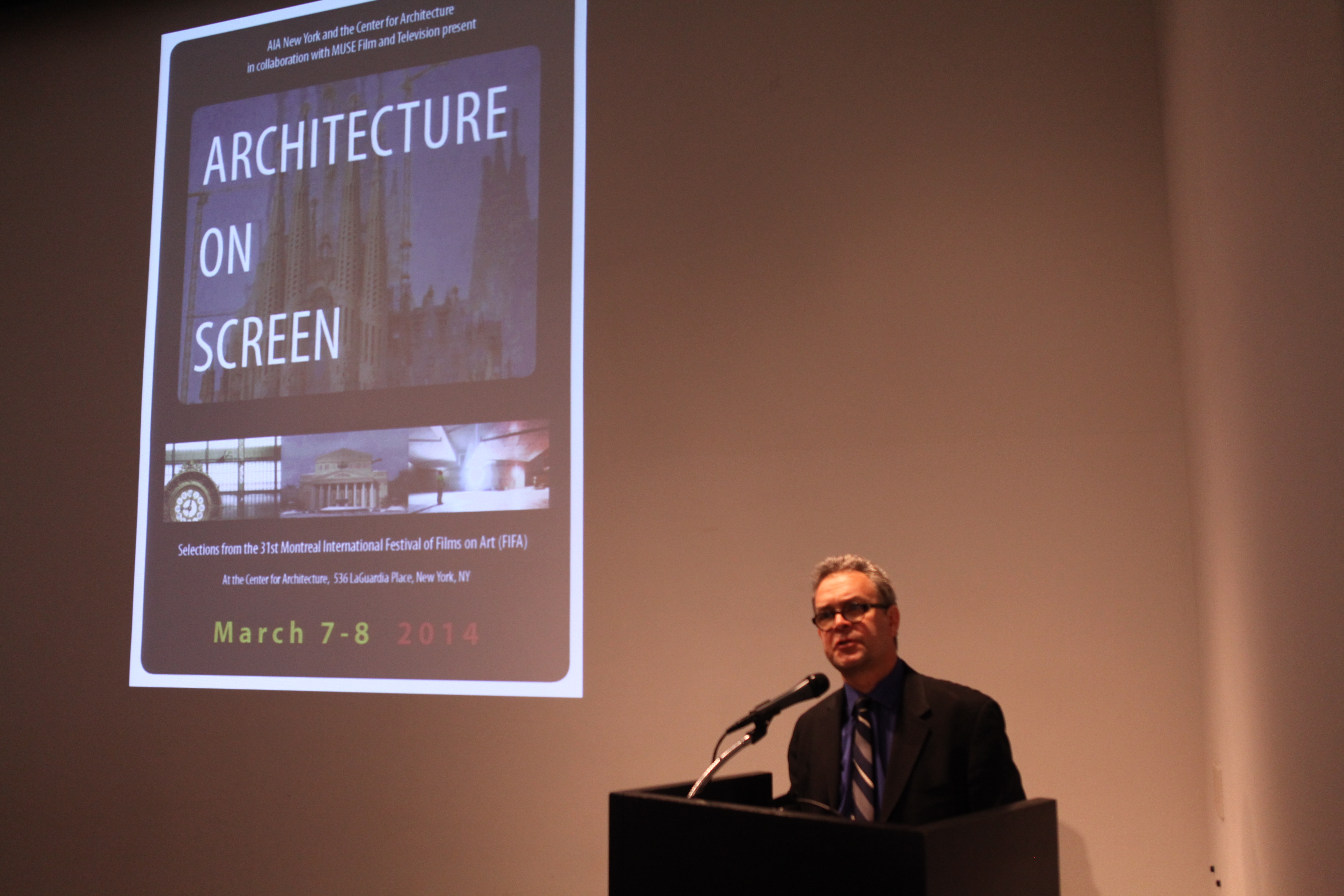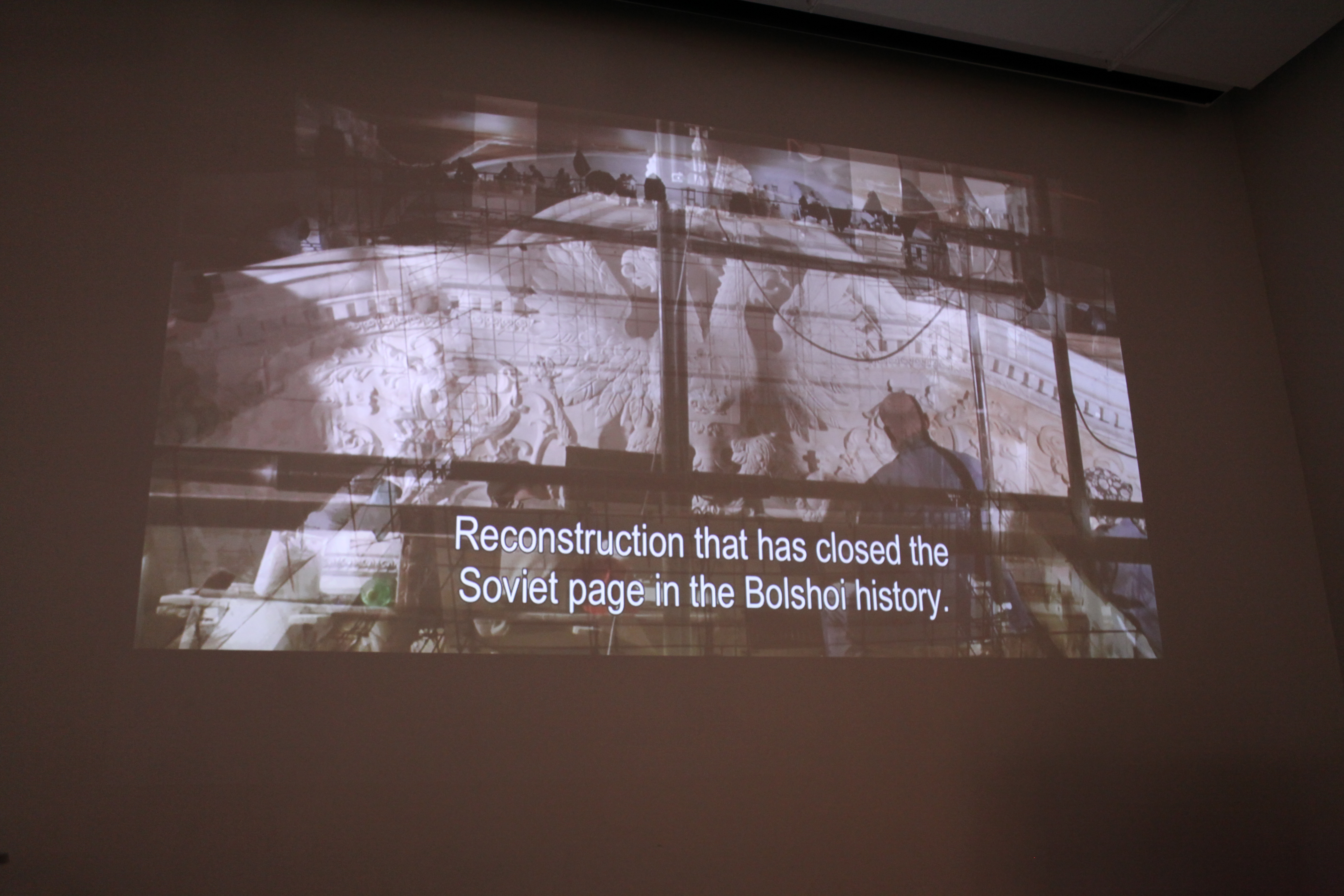by James Way
Last year, the Montreal International Festival of Films on Art (FIFA), the hotbed of international art films that it is, screened 250 films from 28 countries. This year’s “Architecture on Screen,” the fifth annual at the Center for Architecture, captured seven of those films for two days of architecture, film, and conversation.
The opening film, Bolchoï, A Renaissance by director Denis Sneguirev, set one strand of the films to follow: the building and restoration of large-scale, national landmarks. Moscow’s Bolshoi Theater opened in 1824 to epitomize Russian ballet and opera, yet became quite unkempt and was breaking apart (literally). The film follows the theater’s extensive structural, acoustic, and aesthetic six-year restoration. Guarding culture on all levels, a chief security officer points out door pulls “touched by Nicholas the Second in 1856,” while engineers describe how the building was shored and stabilized. Having detailed design and history, the film ends with a beautifully restored landmark and portraits of the workers who made it happen.
Both Helsinki Music Centre – Prelude, directed by Matti Reinikka and Miisa Latikka, and Sagrada — The Mystery of Creation, directed by Stefan Haupt, highlight the trials and tribulations of large-scale projects. The former was completed in 2011 – 12 years after a competition began the architectural process, which was won by LPR Architects’ chief architect Marko Kivistö, and relentlessly supported by the center’s director, performers, and patrons. Farther south, La Sagrada Familia, under construction since Antonio Gaudí began it in1882, has years until completion. Sagrada, the film shows, straddles and divides opinions while trying to remain of its time and true to Gaudí’s vision – from abstract sculptures, to parametric design, to social relevance.
Not explicitly an architecture movie, Bruno Ulmer’s Orsay features the operations of Paris’s Musée d’Orsay and its 25th anniversary renovation. Built as a train station in 1900, the symbol of modernity sat empty for decades until 1981 when competition-winner Gae Aulenti transformed it into a museum for early modern art. Conversely, Tufic Makhlouf Akl’s The Barragán House: A Universal Value dissects Pritzker-winner Luis Barragán’s home and studio. At once a chronological history and a poetic examination, the director focuses on the building’s interaction with the garden, qualities of light and color, and themes of solitude and silence. Historical facts and anecdotes punctuate the journeys through the spaces and details.
Intercalary Space / Espaces intercalaires, directed by Damien Faure, investigated intimate spaces. The semi-fictional movie follows two characters moving through Tokyo’s rhythms and transformations. Exploring various scales of the city, hidden and leftover spaces are revealed. Interviews with a handful of contemporary architects and the buildings’ users round out Atelier Bow-Wow’s Yoshiharu Tsukamoto’s conception of “pet architecture” – small buildings that take on extreme conditions of leftover spaces, such as restaurants, shops, and homes.
In a discussion between Faure and Berry Bergdoll, Faure revealed that the film’s inspirations were indeed Atelier Bow-Wow’s “Pet Architecture,” an ArchiLab exhibition and catalog, and Edward Hall’s 1966 classic study of spatial perception Hidden Dimension. While mixing actors and architects, documentary and fiction, Bergdoll commended the film for “folding in other ways of understanding space, not oriental or occidental.” Rare indeed is an architecture film that interviews an ornithologist and entomologist to help explain, as Faure said in the introduction, “a notion of space understood by different creatures.”
New York’s own Muffie Dunn and Tom Piper bring us Diller Scofidio + Renfro: Reimagining Lincoln Center and the High Line. While the documentary focuses on two projects, the directors use the opportunity to provide an exposé of the firm and the story of New York’s urban transformations, then and now. Piper interviews numerous clients and colleagues, of whom Mark Wigley makes repeated poignant and humorous comments. Extensively shown in festivals and on PBS, if you haven’t seen it you should, whether you like the firm’s work or not. Few films say more about contemporary New York or ways of practicing architecture.
In conversation with James Sanders, AIA, Piper outlined his themes of “see and be seen” on the High Line and the public and private dialectic at Lincoln Center, and how both projects attempt to reveal the hidden – whether history, architectural language, or spatial relations. Sanders conceded that the film did make him want to revisit these spaces and look at them again. Indeed, good films and architecture invite repeated viewing.
James Way, Assoc. AIA, Marketing Manager at Dattner Architects, frequently contributes to eOculus.
Event: Architecture on Screen: Selections from the 2013 Montreal International Festival Films on Art (FIFA)
Location: Center for Architecture, 04.07–08.14
Speakers: Rick Bell, FAIA, Executive Director, AIA New York Chapter; Nadine Covert, New York Delegate, FIFA; Damien Faure, Director; Berry Bergdoll, Meyer Schapiro Professor of Art History in the Department of Art History and Archaeology, Columbia University, and a curator of architecture, Museum of Modern Art; James Sanders, AIA, Principal, James Sanders + Associates; Tom Piper, Director of Production, Checkerboard Film Foundation,
Organizers: Center for Architecture and MUSE Film and Television
Sponsors: Québec Délégation Générale New York; Festival International Du Film Sur L’Art; and Consulate General of Switzerland



